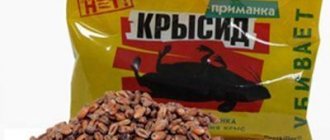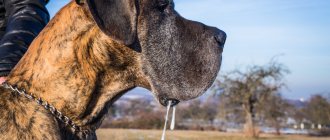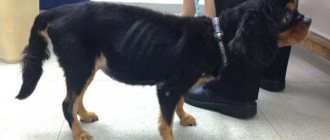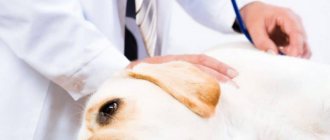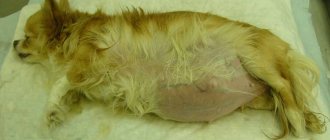Dogs are very inquisitive animals. And this character trait sometimes gets our dogs into trouble. A curious animal, having discovered an unfamiliar substance, may want to taste it. This is where the danger lurks - the substance may well turn out to be poison, and most often animal owners whose pets have tasted rat poison turn to veterinary clinics. Poisoning with this chemical is dangerous and difficult for a dog to tolerate: in the article we will tell you how a dog’s poisoning with rat poison manifests itself symptomatically, and we will find out what measures need to be taken to save the animal.
Methods of poisoning
Although rat poison poses a serious danger to dogs, poisoning with this substance is not common in practice. The appearance of the bait, its smell and the shape of the granules are not attractive to the animal, so the dog does not always taste the rat “sweetness”. In addition, in order to get really serious, life-threatening poisoning, the dog will have to eat a fairly large amount of poison, which is impossible in most cases.
However, sometimes rat traps are made with an admixture of meat ingredients. This is where rat poison poses a serious threat to dogs, since the toxic substance mixed with meat can be absorbed by animals unnoticed and in any quantities. In addition, sometimes the dog eats the rats themselves, who died as a result of poisoning.
Danger of poison
Rat poison can vary in the way it affects the body of rodents and, accordingly, dogs. Thus, anticoagulants such as warfarin, triphenacin and others are most often used in baiting rats. The principle of action of these substances is based on the loss of blood's ability to clot and disruption of the synthesis of vitamin K in the body.
Poisons in this category can be easily eliminated from the body, and among dogs, some breeds show individual sensitivity to warfarin. If the dose of the substance exceeds 6 mg per kilogram of dog weight, the animal dies.
Substances called second-generation anticoagulants - and these are flocoumarin, brodifacoum and others - have a more dangerous toxic effect. They are not eliminated from the body as easily as poisons of the first category, but have the ability to accumulate.
For a dog to die, a kilogram of its weight must be exposed to 3.5 mg of such poison. Rat venom is highly toxic, which is why it is rarely used. As a result of exposure to this poison, the dog may experience pulmonary edema, vascular pathologies, and limb spasms. For an animal to die, exposure to 60-150 mg of poison per kg of weight is necessary.
A toxic substance such as zinc phosphide has the highest toxic ability, and therefore is used only by professional pest control specialists. When ingested, this substance corrodes the gastric mucosa and has a destructive effect on the nervous system.
Note that most often rats are poisoned with anticoagulants, and in this case, a dog that has eaten poison will show signs of intoxication no earlier than three days later. This delay is explained by the reserves of vitamin K in the animal’s body, which for the time being restrains intoxication.
Symptoms of dog poisoning
Let's find out how you can understand that a dog has been poisoned by rat poison. First, let's look at the signs of animal poisoning with rat anticoagulant poison - as we have already found out, the most common type of chemical when baiting rodents.
- The animal experiences weakness, becomes lethargic, apathetic, and constantly lies down;
- The dog has severe, severe shortness of breath;
- The dog's mucous membranes turn pale, including the surface of the tongue;
- Possible nosebleeds. The gums also often ooze blood;
- The animal stops eating.
If the case is severe, the following symptoms of rat poisoning in dogs are possible: bleeding during defecation and urination, subcutaneous hemorrhages in the form of hematomas on the body. The animal experiences pain in the abdominal area - this can be checked by palpation. A dog with severe poisoning walks with difficulty, limping. In addition, the dog is coughing, and also with blood. In severe poisoning, the animal usually dies as a result of multiple hemorrhages.
However, with timely veterinary care, the dog can be saved in 85% of all cases. After rescuing the animal, it is important to remember that now contact with rat poison for the pet should be completely excluded. If a dog has been poisoned once, in the future it will develop increased sensitivity to the substance.
A poison such as zinc phosphide is now used extremely rarely, so a dog practically cannot come into contact with this substance. However, in rare cases of contact, signs of poisoning will be as follows:
- the dog vomits, sometimes with blood;
- severe diarrhea occurs;
- the animal is constantly thirsty;
- apathy, weakness simultaneously with nervous anxiety;
- hard breath;
- the animal's pupils are dilated;
- limb spasms;
- loss of consciousness.
In case of rat poisoning, the symptoms will be as follows:
- weak pulse;
- severe vomiting;
- pallor of mucous membranes;
- urinary retention, sometimes significant;
- convulsions.
In case of poisoning with ratsid and zinc phosphide, the first signs of illness will appear in the dog much earlier than with intoxication with anticoagulants. In case of poisoning with potent substances, alarming symptoms become noticeable within a few hours.
Contacting a veterinarian
For a faster diagnosis, be sure to bring a sample of vomit with you to your appointment. In addition to studying them, you will need:
- pass general and biochemical blood and urine tests;
- undergo an ultrasound, ECG and x-ray.
In an emergency, only a blood test is taken from the four-legged patient to determine the type of rodenticide. All other studies are carried out after the condition has stabilized. Their results help to identify the damage suffered and select symptomatic therapy.
Diagnosis of dog poisoning by rat poison
First, let’s reassure dog breeders: if you notice signs of rat poisoning in dogs in time and take measures to save the animal, then the prognosis in most cases is favorable. First you need to provide your pet with all possible first aid.
First aid measures
First you need to try to induce vomiting in the animal. To do this, you can do gastric lavage. For the procedure you will need a 20 ml syringe without a needle. It is necessary to fill the syringe with water and inject a stream of liquid into the animal’s mouth. Then you need to provoke vomiting: to do this, press on the root of the dog’s tongue.
If a puppy is poisoned, it is enough to use 20 ml of liquid to rinse its stomach:
- the average dog will need two syringes (40 ml);
- large - 34 syringes (60-80 ml).
It is recommended to use clean boiled water for the procedure, and not herbal decoctions, infusions or potassium permanganate solution. According to some reports, a solution of potassium permanganate has an irritating effect on the gastric mucosa, and even corrodes the latter to some extent. It is for this reason that potassium permanganate has now disappeared from the shelves of many pharmacies.
The use of sorbents can also be beneficial in case of poisoning. Sorbents are substances that bind, neutralize and remove toxins from the body. The following are suitable sorbents:
- Activated carbon;
- Enterosorb;
- Polysorb MP;
- Polyphepan.
It is necessary to feed the dog with decoctions with a high mucus content. Rice, oatmeal, and flaxseed infusions are suitable. It won't hurt to give the animal a laxative. Magnesium sulfate can be used as an effective drug in this case.
The animal's intestines can be cleansed with an enema. It is advisable to use a small volume bulb (50-100 ml) for this purpose. The procedure must be carried out with warm water, and preferably in several stages.
The animal must be given frequent and abundant water. With vomiting and diarrhea, which usually accompany poisoning, rapid dehydration occurs. It is necessary to replenish the lack of fluid. Give your dog plain water, without gas or any added medications. It is recommended to pour 10 ml of liquid into the mouth of an animal every 10 minutes, and 5 ml of a small dog.
It is prohibited to feed the dog immediately after poisoning. It is better to remove the food bowl from the animal altogether while the pet's digestive system needs rest. Giving food can only be started after permission from the veterinarian.
What not to do if poisoned
When rescuing a beloved animal, owners are ready to go to any lengths to save their pet’s life. However, you shouldn’t lose your head: there are some things that are best avoided when helping a dog that has suffered from intoxication.
If more than 4-6 hours have passed since the moment of poisoning, inducing vomiting is not only useless, but also harmful. Firstly, by this time all the contents of the stomach have already descended into the intestines, and secondly, artificially induced vomiting greatly weakens the dog’s body. And this method can only be used when it makes sense, namely within 1-2 hours after poisoning.
Even if little time has passed since the poisoning, vomiting should not be induced when:
- the dog has seizures;
- paralysis;
- loss of consciousness.
A dog poisoned by rat poison should not be given foods such as milk, vegetable oils, eggs: when interacting with zinc phosphide, these products will aggravate the negative effects of the poison. Castor oil is not given to dogs for the same reason.
When poisoning with zinc phosphide, you need to remember that this substance is extremely toxic, so when rescuing a dog you need to take care of your own safety. It is better to carry out all rescue procedures outdoors or in a ventilated room. If possible, it is advisable to leave medical procedures to professionals.
First aid kit
Experts have developed a special list of medications that should be in the home of every dog owner. Such items and medications will make the owner of a 4-legged friend fully prepared to provide first aid in case of poisoning. This list included:
- 3% peroxide solution;
- a set of syringes of different sizes, which are intended for washing the eyes;
- a rubber bulb necessary for cleaning the mouth;
- several packages of activated carbon;
- thermometer;
- numbers of veterinarians, emergency services for 4-legged animals.
Professional treatment
If the dog has eaten very little poison, and the poisoning has not progressed to a mild stage, inducing vomiting in the animal, sorbents and laxatives is usually sufficient. As a rule, these measures are enough for the dog to return to relative normality after a few hours. Well, after a few days, the symptoms of a dog being poisoned by rat poison will disappear completely.
In advanced cases, sometimes even a blood transfusion is required if the intoxication is too significant. Vitamin K is administered in this case by subcutaneous injection. Most likely, a dog with severe poisoning will require antibacterial treatment, as well as replenishment of iron deficiency in the body.
When an animal with poisoning arrives at the clinic, the veterinarian first conducts an external examination. In this case, the owner must tell the doctor as accurately and in detail as possible where and under what circumstances the dog tasted the poison, and mention all the symptoms that the animal experienced due to poisoning.
The dog is injected with vitamin K - this antidote is used for rodenticide poisoning. This is followed by symptomatic treatment, during which all the consequences of poisoning are systematically eliminated from the animal. To eliminate the consequences of intoxication, the veterinarian can use the following types of drugs:
- sorbents;
- salt-based laxative;
- painkillers if necessary;
- anti-inflammatory;
- diuretics;
- corticosteroids;
- cardiac drugs;
- antibiotics.
If a dog has tasted zinc phosphide, Maalox may be prescribed as treatment, which helps reduce the amount of toxins in the body and remove them out. The introduction of regular activated carbon and gastric lavage in several doses after this will also help the animal.
If the dog is in serious condition, he will most likely remain in the clinic for several days. If the dog’s condition is stable, after first aid is provided, it is discharged home with precise instructions for the owner of all subsequent steps: visits to the clinic, assistance, recommendations on diet, maintenance.
If the dog is severely poisoned, the course of treatment may take a month. Throughout this period, the animal is regularly administered an antidote in the form of vitamin K, and blood transfusions are given as necessary. Symptomatic treatment is carried out simultaneously with the main one.
Animal examination
To identify complications from internal organs and systems, the veterinarian may prescribe a number of laboratory and instrumental examinations:
- A general blood test will help identify hemolysis of red blood cells and anemia.
- A general urine test is necessary to diagnose kidney damage.
- A biochemical blood test is performed to determine the performance of the pancreas, liver and kidneys.
- Ultrasound examination (ultrasound) of internal organs can help identify acute damage.
- ECG, echocardiography is indicated for the development of heart failure.
- X-ray of the head - if a hemorrhagic stroke is suspected.
The veterinary clinic may not have sufficient equipment to perform these tests, and you will be sent to another veterinary hospital to complete the diagnosis.
Consequences
Poisoning with rat poison in a mild form and with prompt medical care usually goes away without a trace for dogs. Apart from several days of depressed mood in the animal and lack of appetite.
If the intoxication is significant, complications associated with liver function most often occur. In particular, the liver begins to have problems regulating blood clotting. For this reason, hemorrhages are so common when poisoned by rat poison. If the liver is severely damaged, death is likely.
For preventive purposes, do not let your dog off the leash while walking, especially if you are near old buildings with basements, attics, and warehouses. Read announcements from utility companies and sanitary and epidemiological stations: the time and place of large-scale pest control are usually warned in advance.
We learned what danger rat poison poses to dogs, and what can be done if your pet is poisoned by this substance. Rat poison can not only have a negative impact on the health and well-being of the dog, but can also lead to the death of the animal. To protect your dog from poisoning, take precautions when walking, and immediately take your pet to the clinic at the first signs of intoxication.
Currently reading:
- Seven Signs and Remedies for Getting Rid of Fleas in Dogs
- Thyroid dysfunction in dogs (hypothyroidism)
- What to do if your dog has an abnormal bite
- First aid for a dog if it is poisoned
Precautionary measures
Unfortunately, in this case it is impossible to guarantee that your pet is completely safe. He can encounter poison anywhere. Try to walk with your dog, be sure to put a muzzle on it, and do not let it off the leash in places where cases of poisoning of pets have already been recorded.
Carefully follow the announcements of the local sanitary and epidemiological station: if they include rodent control, it is generally better to avoid walking with your dog. The consequences of poisoning are more severe after a week spent at home or in an enclosure.
